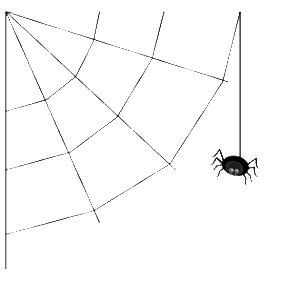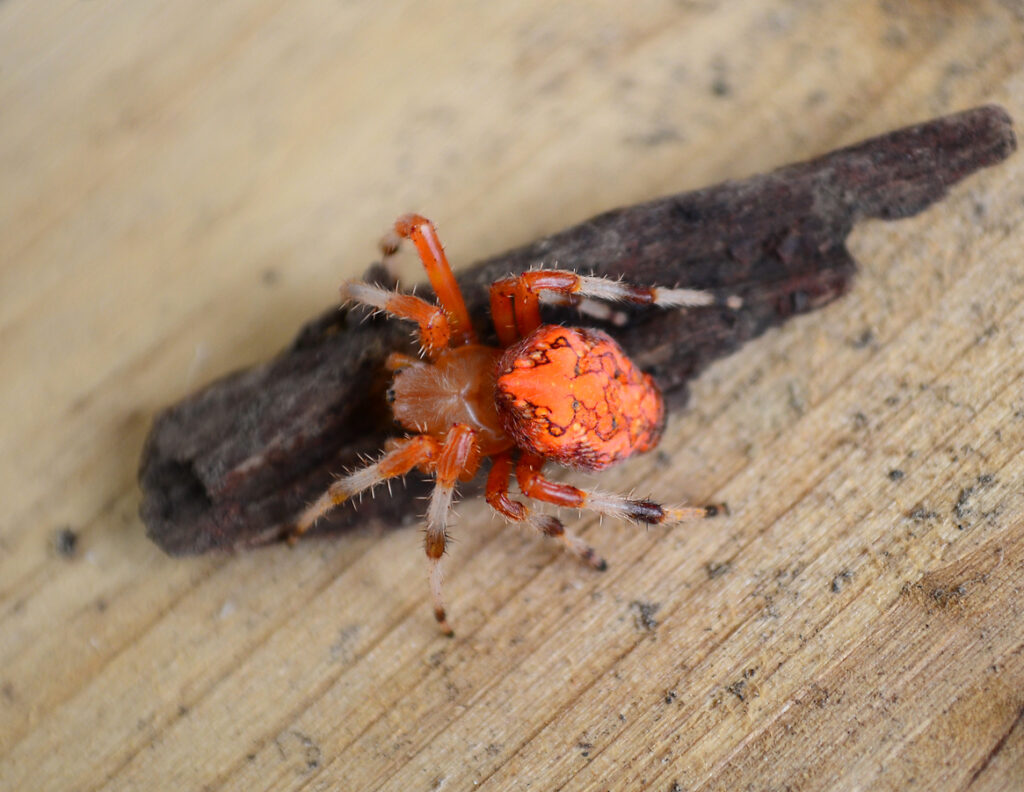 Creepy Spiders of Georgia
Creepy Spiders of Georgia
When I think about Halloween and the spooky season, I can’t help but think about the creepy, crawly world of spiders. So join me as we explore the creepiest of the creepy spiders in Georgia!!
Pumpkin Spider
What could be more appropriate to the holiday, than starting out with the pumpkin spider?? When I tell you this is a weird-looking spider, I am not exaggerating. It seriously looks like a pumpkin with legs. This spider is also known as the Marbled Orb-weaver, and my research shows it has been spotted in 20 different states and 3 countries; although my guess is there are more…And get this, the month they are most often spotted is October. They literally come out for Halloween!
The coloring is darker orange marbled with lighter orange, yellows, black, and tan. They usually reach a maximum size of one inch, and the abdomen area expands around October making them easier to spot. Like all orb weavers, the pumpkin spider spins a large web and waits for prey to drop in for a visit. Their bite is not typically dangerous to humans, but any spider bite should be evaluated by your physician.
Writing Spider
Moving along, let’s look at the writing spider, okay the actual name is writer spider, but here in the South, I was taught it was called the writing spider. And umm, I might have a little childhood trauma when it comes to this bad boy. As a kid, my grandparents used to say that you should never mention a person’s name in the presence of a writing spider, because if your name ended up written on the web, it would be bad! Why? I have no idea, but bad is bad. Years later as a parent myself, I think they just wanted some peace and quiet, so this threat kept us kids silent from the sheer terror of this unknown but dreaded ‘bad’!
I’m okay now, well mostly. Let’s look at the facts! Facts fight fear.
A female writing spider can be about 1.2 inches in length while the male is a little smaller. The coloration is black and yellow. Many people confuse this native spider with the new arrival, the Joro spider. The most usual way we can identify this spider is by looking at the web where it spends the majority of its time. The web can be 2 feet in diameter and have a zigzag pattern, thus the appearance of ‘writing’. These spiders keep their unique orange and yellow colored egg sacs close to them in the web itself. The inconvenience of this gal is where she likes to build her web. Outside your doors and windows is a scary place to come face to face with a 2-foot web and a colorful 1.2-inch spider, so although they are not dangerous to humans (again individual response can vary based on the response so always see a doctor if bitten), they can cause a panic attack if you run into them! And by the way, I have to admit, I still walk silently by those zigzag webs just in case. SHHH
Trapdoor Spider
This variety is one you have not likely seen because they are ground dwellers. They build a silk-like burrow with a trapdoor at the surface. The females can be a whopping 2 inches long, making them the largest in their particular order, mygalomorph. Intensely shiny, they are said to look almost varnished in appearance. The trapdoors themselves are amazing creations and are solid, well-camouflaged, and about an inch around. As far as the burrow, it is fairly small at about 4-6 inches. Trapdoor spiders have many enemies, including wasps, and when it comes to defending themselves, well it’s a rather crazy show of strength on the spider’s part. If the door is disturbed by an enemy, she puts her fangs into the door and holds the side of the small burrow with all 8 of her legs. And how does she get prey, you might ask. Well, the spider creates silk ‘trip’ lines to alert her to the presence of lunch, and surprise, out she pounces! Shivers!
So how does the spider know whether its prey or predator is knocking at the door? Even with an element of fear, I say this is amazingly cool…The spider judges the vibration type and strength to determine which is which. And get this, trapdoor spiders have a “code” they tap on the web to one another to let them know a friend approaches, so put your fangs away.
You’ve got to admit, that’s just a wow factor.
If you’re wondering about the danger to humans, first of all, it is unlikely you’re going to come in contact with a trapdoor spider unless you go digging in their trapdoor. I’m not, so I won’t. But if you do, some say it is no worse than a bee sting and as always, consult your physician for your personal health needs.
Spitting Spider
Seriously, this one is the most fascinating of the bunch! I’m not sure my nightmares could even prepare me for the spitting spider. The Scytodaes thoracica, as they are scientifically named, captures and paralyzes its hapless prey using a sticky venomous silk strand that it actually shoots right out of its head!
Read that again!
It shoots a venomous strand of silk out of its head…and it can be found in every single state in the United States. In case you’re already packing your bags, they are found throughout the world, so there goes that idea. Want to know more? They measure the distance between themselves and their prey by stretching out their front legs, then with spidery caution they get closer to the unsuspecting prey. Zap! The liquid, venom-filled silk covers the prey and quickly solidifies and shrinks with air contact. There’s more, but that’s enough of a visual image for you and for me! They are effective hunters, enough said.
Most insect experts will tell you it is easy to identify the spitting spider because of its appearance. They are light brown with dark brown dots and patterns. Even the legs are light brown with dark-colored bands. Another unique feature is the size of the abdomen. Most spiders have a larger back end (abdomen) compared to the front end (cephalothorax). But this spider has a larger front end than a back end. The front cephalothorax is also shaped like a dome, and if you want to get really close…this spider only has 6 eyes. Most spiders have 8, so there’s that. Personally, I will never, ever get close enough to a spider to count its eyes. And a spider that spits venomous silk, nope, just nope. They only reach a length of ¾ of a length including the legs so smaller than our previous spider friends.
Well, that’s it! There are many more cool and creepy spiders, but we will stop for the day with these. Spiders play an important role in our ecosystem, so as long as they stay in their zone, we should leave them. For the most part, spiders aren’t trying to get inside your home, although it does happen. The reason it happens is typically because food is present and easily available. By food I mean things like ants, roaches, and even termites. Few spiders are single prey hunters so it’s all up for dinner negotiations when it comes to spider appetites. Preventative and ongoing pest control is your solution. Get rid of the insects in your house, and the spiders have little interest in being your housemate. Other than that, spiders and insects will wander in if your home has cracks and crevices that aren’t sealed or through open doors and windows. Take care of those issues and you’ll find your home less prone to insect or arachnid invasions.
If you need assistance getting any creepy crawlies out of your home, give us a call at 770-479-1598.
Canton Termite is always happy to help keep your home pest-free!
*Special thanks to Nic Alday for the arachnid knowledge that made this article so cool!
